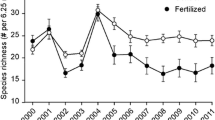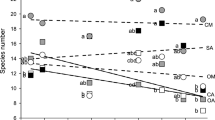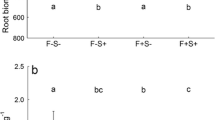Abstract
The establishment pattern of monocultures of 61 species common to Central European semi-natural grasslands was analysed in a field experiment. The objectives were to identify key traits for successful establishment, defined in terms of above-ground biomass production, and to characterize the degree of niche overlap with respect to the use of above-ground resources, such as light and space. Four months after sowing, 15 species reached an above-ground biomass of more than 400 g m−2. Highly productive monocultures adopted extremely different strategies of space filling in terms of canopy height, biomass density and centre of gravity of vertical biomass distribution. Regression tree analysis identified (1) the number of seedlings and (2) a trade-off between the development of a large number of small-sized shoots of species with intensive clonal growth in contrast to the establishment of fewer large-sized shoots as the two most important traits for successful establishment. Further variables associated with high above-ground biomass production by individual species were traits known to be relevant to the relative growth rate of herbaceous species, such as specific leaf area, leaf nitrogen or allocation between shoots and roots. The principle finding of this study is that the success of the 15 most productive species was not based on a single pathway but on a variable combination of traits. There are clearly many possible combinations of morphological and physiological features that will result in a species becoming productive, and these combinations differ among species in a local species pool.





Similar content being viewed by others
References
Aerts R, Chapin FS III (2000) The mineral nutrition of wild plant species revisited: a re-evaluation of processes and patterns. Adv Ecol Res 30:1–67
Barkman JJ (1979) The investigation of vegetation texture and structure. In: Werger MJA (ed) The study of vegetation. Dr. W. Junk, The Hague, pp 123–160
Bloom AJ, Chapin FS, Mooney HA (1985) Resource limitation in plants – an economic analogy. Annu Rev Ecol Syst 16:363–392
Cornelissen JHC (1996) An experimental comparison of leaf decomposition rates in a wide range of temperate plant species and types. J Ecol 84:573–582
Cornelissen JHC, Thompson K (1997) Functional leaf attributes predict litter decomposition rate in herbaceous plants. New Phytol 135:109–114
Cornelissen JHC, Lavorel S, Garnier E, Díaz S, Buchmann N, Gurvich DE, Reich PB, ter Steege H, Morgan HD, van der Heijden MAG, Pausas JG, Poorter H (2003) A handbook of protocols for standardised and easy measurement of plant functional traits worldwide. Aust J Bot 51:335–380
Craine JM, Tilman D, Wedin D, Reich P, Tjoelker M, Knops J (2002) Functional traits, productivity and effects on nitrogen cycling of 33 grassland species. Funct Ecol 16:563–574
Crawley MJ (2002) Statistical computing. An introduction to data analysis using S-Plus. Wiley, Chichester
De`ath G, Fabricius KE (2000) Classification and regression trees: a powerful yet simple technique for ecological data analysis. Ecology 81:3178–3192
Díaz S, Cabido M (2001) Vive la différence: plant functional diversity matters to ecosystem processes. Trends Ecol Evol 16:646–655
Díaz S, Hodgson JG, Thompson K, Cabido M, Cornelissen JHC, Jalili A, Montserrat-Martí G, Grime JP, Zarrinkamar F, Asri Y, Band SR, Basconcelo S, Castro-Díez P, Funes G, Hamzehee B, Khoshnevi M, Pérez-Harguindeguy N, Pérez-Rontomé MC, Shirvany FA, Vendramini F, Yazdani S, Abbas-Azimi R, Bogaard A, Boustani S, Charles M, Dehghan M, de Torrres-Espuny L, Falczuk V, Guerrero-Campo J, Hynd A, Jones G, Kowsary E, Kazemi-Saeed F, Maestro-Martínez M, Romo-Díez A, Shaw S, Siavash B, Villar-Salvador P, Zak MR (2004) The plant traits that drive ecosystems: evidence from three continents. J Veg Sci 15:295–304
Ellenberg H (1988) Vegetation ecology of central Europe. Cambridge University Press, Cambridge
Enquist BJ, Niklas KJ (2002) Global allocation rules for patterns of biomass partitioning in seed plants. Science 295:1517–1520
Eviner VT (2004) Plant traits that influence ecosystem processes vary independently among species. Ecology 85:2215–2229
Eviner VT, Chapin FS III (2003) Functional matrix: a conceptual framework for predicting multiple plant effects on ecosystem processes. Annu Rev Ecol Syst 34:455–485
Fenner M (1983) Relationships between seed weight, ash content and seedling growth in twenty-four species of composite. New Phytol 95:697–706
Fenner M (1987) Seedlings. New Phytol 106[Suppl]:35–47
Fonseca CR, Overton JM, Collins B, Westoby M (2000) Shifts in trait-combinations along rainfall and phosphorus gradients. J Ecol 88:964–977
Garnier E (1991) Resource capture, biomass allocation and growth in herbaceous plants. Trends Ecol Evol 6:126–131
Garnier E (1992) Growth analysis of congeneric annual and perennial grass species. J Ecol 80:665–675
Garnier E, Laurent G, Bellmann A, Debain S, Berthelier P, Ducout B, Roumet C, Navas ML (2001) Consistency of species ranking based on functional leaf traits. New Phytol 152:69–83
Garnier E, Cortez J, Billès G, Navas M-L, Roumet C, Debussche M, Laurent G, Blanchard A, Aubry D, Bellmann A, Neill C, Toussaint JP (2004) Plant functional markers capture ecosystem properties during secondary succession. Ecology 85:2630–2637
Geber MA, Griffen LR (2003) Inheritance and natural selection on functional traits. Int J Plant Sci 164[Suppl 3]:21–42
Gibson CWD, Dawkins HC, Brown VK, Jepsen M (1987) Spring grazing by sheep: effects on seasonal changes during early old field succession. Vegetatio 70:33–43
Grime JP, Hodgson JG (1987) Botanical contributions to contemporary ecological theory. New Phytol [Suppl]106:283–295
Grime JP, Thompson K, Hunt R, Hodgson JG, Cornelissen JHC, Rorison IH, Hendry GAF, Ashenden TW, Askew AP, Band SR, Booth RE, Bossard CC, Campbell BD, Cooper JEL, Davison AW, Gupta PL, Hall W, Hand DW, Hannah MA, Hillier SH, Hodkinson DJ, Jalili A, Liu Z, Mackey JML, Matthews N, Mowforth MA, Neal AM, Reader RJ, Reiling K, Ross-Fraser W, Spencer RE, Sutton F, Tasker DE, Thorpe PC, Whitehouse J (1997) Integrated screening validates primary axes of specialisation in plants. Oikos 79:259–281
Groffman PM, Eagan P, Sullivan WM, Lemunyon JL (1996) Grass species and soil type effects on microbial biomass and activity. Plant Soil 183:61–67
Gross KL (1984) Effects of seed size and growth form on seedling establishment of six monocarpic perennial plants. J Ecol 72:369–387
Harper JL (1977) Population biology of plants. Academic, London
Hilbert DW (1990) Optimization of plant root-shoot ratios and internal nitrogen concentration. Ann Bot 66:91–99
Hirose T, Werger MJA (1995) Canopy structure and photon flux partitioning among species in a herbaceous plant community. Ecology 76:466–474
Hooper DU, Chapin FS III, Ewel JJ, Hector A, Inchausti P, Lavorel S, Lawton JH, Lodge DM, Loreau M, Naeem S, Schmid B, Setälä H, Symstad AJ, Vandermeer J, Wardle DA (2005) Effects of biodiversity on ecosystem functioning: a consensus of current knowledge. Ecol Monogr 75:3–35
Hunt R, Cornelissen JHC (1997) Components of relative growth rate and their interrelations in 59 temperate plant species. New Phytol 135:395–417
Kluge G, Müller-Westermeier G (2000) Das Klima ausgewählter Orte der Bundesrepublik Deutschland: Jena, Berichte des Deutschen Wetterdienstes 213
Lambers H, Poorter H (1992) Inherent variation in growth rate between higher plants: a search for physiological causes and ecological consequences. Adv Ecol Res 23:187–261
Lavorel S, Garnier E (2002) Predicting changes in community composition and ecosystem functioning from plant traits: revisiting the Holy Grail. Funct Ecol 16:545–556
Lavorel S, McIntyre S, Landsberg J, Forbes TDA (1997) Plant functional classifications: from general groups to specific groups based on response to disturbance. Trends Ecol Evol 12:474–478
Leishman MR (1999) How well do plant traits correlate with establishment ability? Evidence from a study of 16 calcareous grassland species. New Phytol 141:487–496
Loreau M, Naeem S, Inchausti P, Bengtsson J, Grime JP, Hector A, Hooper DU, Huston MA, Raffaelli D, Schmid B, Tilman D, Wardle DA (2001) Biodiversity and ecosystem functioning: current knowledges and future challenges. Science 294:804–808
Niinemets Ü (2004) Adaptive adjustment to light in foliage and whole-plant characteristics depend on relative age in the perennial herb Leontodon hispidus. New Phytol 162:683–696
Niinemets Ü (2005) Key plant structural and allocation traits depend on relative age in the perennial herb Pimpinella saxifraga. Ann Bot 96:323–330
Poorter H, de Jong R (1999) A comparison of specific leaf area, chemical composition and leaf construction costs of field plants from 15 habitats differing in productivity. New Phytol 143:163–176
Poorter H, Remkes C (1990) Leaf area ratio and net assimilation rate of 24 wild species differing in relative growth rate. Oecologia 83:553–559
Quinn GP, Keough MJ (2002) Experimental design and data analysis for biologists. Cambridge University Press, Cambridge
Reich PB, Oleksyn J (2004) Global patterns of plant N and P in relation to temperature and latitude. Proc Natl Acad Sci USA 101:11001–11006
Reich PB, Walters MB, Ellsworth DS (1997) From tropics to tundra: global convergence in plant functioning. Proc Natl Acad Sci USA 94:13730–13734
Reich PB, Wright IJ, Cavender-Bares J, Craine MJ, Oleksyn J, Westoby M, Walters MB (2003) The evolution of plant functional variation: traits, spectra, and strategies. Int J Plant Sci 164[Suppl 3]:143–164
Roscher C, Schumacher J, Baade J, Wilcke W, Gleixner G, Weisser WW, Schmid B, Schulze E-D (2004) The role of biodiversity for element cycling and trophic interactions: an experimental approach in a grassland community. Basic Appl Ecol 5:107–121
Rothmaler R (2002) Exkursionsflora von Deutschland. Bd. 4. Kritischer Band. In: Jäger EJ, Werner K (eds) Exkursionsflora von Deutschland, 9th edn. Spektrum Akademischer Verlag, Heidelberg
Ryser P, Urbas P (2000) Ecological significance of leaf life span among Central European grassland species. Oikos 91:41–50
Schulze ED (1982) Plant life forms and their carbon, water and nutrient relations. In: Lange OL, Nobel PS, Osmond CB, Ziegler H (eds) Encyclopedia of plant physiology. Physiological plant ecology II, vol 12B. Water relations and photosynthetic productivity. Springer, Berlin, pp 615–676
Shipley B, Peters RH (1990) The allometry of seed weight and seedling relative growth rate. Funct Ecol 4:523–529
Shipley B, Parent M (1991) Germination responses of 64 wetland species in relation to seed size, minimum time to reproduction and seedling relative growth rate. Funct Ecol 5:111–118
Smith TM, Shugart HH, Woodward FI (1997) Plant functional types and their relevance to ecosystem properties and global change. Cambridge University Press, Cambridge
Sultan SE (1995) Phenotypic plasticity and plant adaptation. Acta Bot Neer 44:363–383
ter Braak CJF, Šmilauer P (1998) CANOCO reference manual and user`s guide to CANOCO for Windows. PUDOC, Wageningen
Tilman D (1988) Dynamics and structure of plant communities. Princeton University Press, Princeton
van der Werf A, van Nuenen M, Visser AJ, Lambers H (1993) Contributions of physiological and morphological plant traits to a species’ competitive ability at high and low nitrogen supply. Oecologia 94:434–440
Walker B, Kinzig A, Langridge J (1999) Plant attribute diversity, resilience, and ecosystem function: the nature and significance of dominant and minor species. Ecosystems 2:95–113
Wardle DA, Barker GM, Bonner KI, Nicholson KS (1998) Can comparative approaches based on plant ecophysiological traits predict the nature of biotic interactions and individual plant species effects in ecosystems? J Ecol 86:405–420
Wedin DA, Tilman D (1990) Species effects on nitrogen cycling: a test with perennial grasses. Oecologia 84:433–441
Wedin DA, Pastor J (1993) Nitrogen mineralization dynamics in grass monocultures. Oecologia 96:186–192
Weiher E, van der Werf A, Thompson K, Roderick M, Garnier E, Eriksson O (1999) Challenging Theophrastus: a common core list of plant traits for functional ecology. J Veg Sci 10:609–620
Westoby M (1998) A leaf-height-seed (LHS) plant ecology strategy scheme. Plant Soil 199:213–227
Westoby M, Falster DS, Moles AT, Vesk PA, Wright IJ (2002) Plant ecological strategies: some leading dimensions of variation between species. Annu Rev Ecol Syst 33:125–159
Acknowledgments
We thank B. Böhme, S. Eismann, I. Hilke, I. Kuhlmann, B. Lenk and H. Scheffler for technical assistance in the field and the laboratory. We also thank B. Schmid and two anonymous referees whose valuable comments helped to improve the manuscript. This study was supported by the Deutsche Forschungsgemeinschaft (DFG), Forschergruppe, “The role of biodiversity for element cycling and trophic interactions – an experimental approach in a grassland community” (FOR 456), with additional support from the Friedrich Schiller University of Jena and the Max Planck Society.
Author information
Authors and Affiliations
Corresponding author
Additional information
Communicated by Bernhard Schmid.
Rights and permissions
About this article
Cite this article
Heisse, K., Roscher, C., Schumacher, J. et al. Establishment of grassland species in monocultures: different strategies lead to success. Oecologia 152, 435–447 (2007). https://doi.org/10.1007/s00442-007-0666-6
Received:
Accepted:
Published:
Issue Date:
DOI: https://doi.org/10.1007/s00442-007-0666-6




